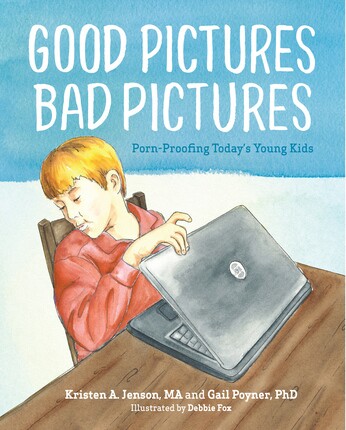Carly (not her real name) was 8 years old when she received a mobile device for her birthday. Carly had also just learned where babies come from because her mom had given her “the talk.” Being curious and imitating how the adults in her life seek information, Carly typed the word “sex” into a search engine to learn more. Four months later, her mom discovered the horrific pornographic videos that her daughter had been viewing from her mobile device.
That was five years ago and the stories like this one (and worse) keep arriving in my email inbox or via social media. No matter how kids are exposed to porn, it negatively impacts them. And often their curiosity to see more pornography feels like the pull of a giant magnet. Unfortunately, most kids are trying to negotiate their hypersexualized world with insufficient help from their parents.
At a recent Utah Coalition Against Pornography conference, Elder Jeffrey R. Holland agreed that pornography has become a public health crisis worthy of the same alarm and attention given to a medical epidemic. Elder Holland admits: “Frankly, until the sirens of a public-health war sound, I fear we will be wholly unsuccessful in this fight.” Pornography represents “the most destructive and evil works of modern times…”
The good news is that many parents are beginning to see the benefits of teaching their young kids to reject pornography. And it’s working! Every week I hear from parents who tell me how their child was exposed to porn and knew exactly what to do by following the CAN DO Plan in my book Good Pictures Bad Pictures: PornProofing Today’s Young Kids. These kids are prepared to close their eyes, label it by saying to themselves, “That’s pornography,” and go and tell a trusted adult. A large part of Good Pictures Bad Pictures is devoted to teaching kids the difference between the thinking brain and the feeling brain, and helping young kids understand how to keep the thinking brain in charge of deciding to reject pornography.
With the ever increasing awareness that pornography is a public health crisis that is harming today’s children, parents need to be proactive in teaching kids how to reject pornography, not just that they should. Here are seven effective strategies to get started on your family’s prevention plan.
Define Pornography
You’d be surprised how many young kids get pulled into porn and never know that what they’re viewing is called pornography. And it may be years before they figure it out if no one ever defines the term for them. Here’s the simple definition that we use in Good Pictures Bad Pictures: “Pornography is pictures, videos, or cartoons of people with little or no clothes on…Pornography shows the parts of the body that we keep private—like the parts we cover with a swimsuit.” Teach kids that no one should ever show them pornography or ask to look at or touch the private areas of their body. Ask them to tell you or a trusted adult right away if this ever happens. (And assure them that they won’t get in trouble for telling!)
1. Be the first to talk about the harms of pornography.
Some parents worry that they’ll awaken a child’s curiosity by talking to them about pornography. Unfortunately, today’s parents have only two choices—be the first to teach a child what porn is and why it’s dangerous OR let the internet, friends, or even a sexual predator entice them into viewing it. Parents need to set themselves up as the experts who can answer their kids’ questions about sex and its dark counterfeit, pornography.
As soon as kids have any access to the internet (including mobile devices or at their grandparents’ house), they need to understand that viewing pornography can be harmful to both their spirit and their brain. Ultimately, kids themselves are going to make the decision to turn away from pornography. Teach them that although it’s normal to be curious, following their curiosity about pornography can be dangerous.
2. Use family home evenings.
Family home evening is a great time to begin these conversations. Parents can help their kids understand that pornography tells lies about how people should treat one another. In addition, continuing to view pornography has the potential to create a destructive addiction.
The Church has developed a series of Family home evening lessons to help parents arm their kids against pornography. Another great resource is the Church’s video “What Should I Do When I See Pornography?” I love how the video models kids learning to reject pornography and talking to their parents about what they’ve seen.
One mom emailed me about her family’s experience talking about pornography:
“We used your book, Good Pictures Bad Pictures, for our family home evening with our eight kids, ages 1-16. Before we met, I read it twice, highlighting the things I wanted to make sure to say, and then just showed them the pictures as we talked about it. This way even the little ones were able to pay attention and we made it through the whole book in one sitting. We had a great discussion and there was such a special feeling as we talked about how they are Heavenly Father's children and they need to stay away from Satan's traps and remain clean, pure, and free.”
Kids will be much safer if parents are the first to teach them what pornography is, why it’s dangerous, and how to reject it.
3. Know your enemy.
Sun Tsu, an ancient Chinese general known for his military genius, taught the importance of knowing your enemy if you want to be victorious in battle. In order for parents to be effective in pornography-proofing their kids, they need to understand the enemies their kids are up against. For example, many LDS parents might think of pornography as the nude centerfold of a men’s magazine or maybe even videos of a man and woman engaging in sex. Sadly, today’s porn has metastasized into 32,000 deviant and violent forms, all easily accessible from any mobile device for free.
Furthermore, hundreds of apps like Hide It Pro allow for hiding videos and pictures on a phone behind something as normal looking as a calculator. And many teens consider sending nude photos of themselves via Snapchat as an acceptable form of flirting. This is the world our kids are growing up in—so parents, know your enemy!
Organizations like Fight the New Drug, the National Center on Sexual Exploitation, and Protect Young Minds are helpful resources to keep parents up to date. It takes minutes per week to stay informed, but the benefits can continue for a lifetime and bless generations.
4. Set an example.
We all know that kids learn best when parents back up their teaching with example. Let your kids see you turning away from pornographic images or commercials. Help kids label sexualized images by saying, “That’s pornography!”
For parents who struggle with pornography, therapist Jeffrey J. Ford advises that “the best gift [parents who are addicted] can give their kids is to start working on their own recovery whether it’s through professional counseling, a…Church leader, or a 12-step program.”
Moreover, Ford encourages parents to tell their kids (who may already secretly know) about their struggles.
“Kids often feel there’s something wrong. [Parents] don’t need to share the details of their addiction or recovery efforts, but it’s a big relief for kids to know that their [parent] is being proactive and getting help.”
5. Help kids meet their emotional needs.
Kids often use pornography to distract themselves from feeling negative emotions like stress, loneliness, or disappointment. Author John Fort makes the case that when “parents can help a child understand what creates a strong desire to see porn, that child has a much better chance of resisting it.” Kids who can understand their emotional needs and find ways to meet them are more resistant to addictions of any kind. Their parents can also model meeting emotional needs. “I’m feeling discouraged so I think I’ll make a list of all of the positive things I’ve done this week.”
Mark Chamberlain, an LDS therapist who specializes in treating sexual addiction and co-author of Love You, Hate the Porn, encourages parents to help their kids emotionally unload at the end of the day by asking two questions, “What was your high” and “What was your low.” He advises parents to empathize with their child’s negative or distressed emotions instead of rushing to solve the problem. This approach teaches kids that it’s okay to feel bad sometimes. “When kids look to us and see that we aren’t scared to sit with difficult feelings, they’ll usually follow our lead and discover that they’re strong enough to handle them as well.”
6. Empower kids to protect their brains.
Many parents teach their young kids body safety rules (keep private parts private!), but today, kids need to learn to protect their brain as well as their body. A large part of Good Pictures Bad Pictures is devoted to teaching kids the difference between the thinking brain and the feeling brain, and helping young kids understand how to keep the thinking brain in charge of deciding to reject pornography.
Another great resource is the Church’s video “What Should I Do When I See Pornography?” I love how the video models kids learning to reject pornography and talking to their parents about what they’ve seen.
7. Counter the impact of technology with regular family councils.
In his April 2016 general conference talk, Elder Ballard taught parents the power of holding family councils.
“A family council, when conducted with love and with Christlike attributes, will counter the impact of modern technology that often distracts us from spending quality time with each other and also tends to bring evil right into our homes.”
Although there was a time when parents could keep kids safe with physical barriers, Elder Ballard acknowledges:
“Those days are now gone. The physical walls, doors, fences, and gates of our homes cannot prevent unseen invasion from the Internet, the Wi-Fi, the mobile phones, the networks. They can penetrate our homes with just a few clicks and keystrokes.”
However, effective family councils can arm families against evil invasions. Elder Ballard teaches that family councils differ from family home evenings because they are primarily for parents to listen to children and engage them to solve specific problems. He reminds parents “that a family council held regularly will help us spot family problems early and nip them in the bud.”
One of my favorite illustrations in Good Pictures Bad Pictures is a family holding up encouraging signs like “You CAN DO it!” and “We’re proud of you!” This picture near the end of our book portrays the truth that when families face pornography together, children aren’t left to face it alone.
Don’t allow your kids to face pornography alone. Use these seven strategies to fortify them and the blessings will be felt for generations.
Check out more ways to pornography-proof your home by reading Kristen A. Jenson's Good Pictures Bad Pictures and visiting her website at protectyoungminds.org.



